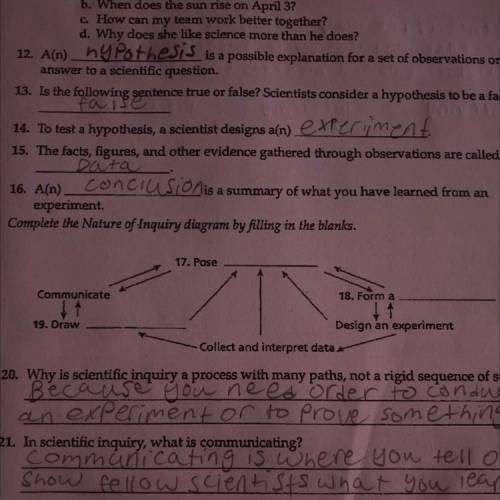Complete the nature of inquiry diagram by filling in the blanks.
...

Biology, 20.09.2021 23:50 vaibhavpatel6
Complete the nature of inquiry diagram by filling in the blanks.


Answers: 3


Another question on Biology

Biology, 21.06.2019 17:00
In tossing one coin 10 times, what are your chances for tossing a head? a tail? 2. in tossing one coin 100 times, what are your chances for tossing a head? a tail? 3. in tossing one coin 200 times, what are your chances for tossing a head? a tail? deviation = ((absolute value of the difference between expected heads and observed heads) + (absolute value of the difference between expected tails and observed tails)) divided by total number of tosses. this value should always be positive. 4. what is the deviation for 10 tosses? 5. what is the deviation for the 100 tosses? 6. what is the deviation for 200 tosses? 7. how does increasing the total number of coin tosses from 10 to 100 affect the deviation? 8. how does increasing the total number of tosses from 100 to 200 affect the deviation? 9. what two important probability principles were established in this exercise? 10. the percent of occurrence is the obtained results divided by the total tosses and multiplied by 100%. toss the coins 100 times and record your results. calculate the percent occurrence for each combination. percent head-head occurrence: percent tail-tail occurrence: percent head-tail occurrence:
Answers: 1

Biology, 21.06.2019 21:00
Epinephrine is a hormone released from the adrenal gland of the body, most often in a stressful situation. it is known as the "fight-or-flight" hormone. one way that it causes a response in the body is to activate receptors on muscle cells. where are these cellular receptors located? a. on the cell membrane b. in the nucleus c. on the cell wall d. around the mitochondria
Answers: 1

Biology, 22.06.2019 14:30
Which of these is not an example of molecular homology? 1. use of dna and rna as genetic material 2.use of glycolysis as the first step in cellular respiration in both plants and animals 3. the lack of an igf-1 gene in prokaryotes 4. the use of aldolase b to break down fructose in bacteria, plants and animals
Answers: 3

Biology, 22.06.2019 17:20
Protein and polypeptide sequences can be determined by first partially hydrolyzing the protein or polypeptide followed by amino acid sequencing of the fragment pieces using the chemical degradation process known as edman degradation. determine the sequence of the initial (18-amino acid) polypeptide that produces the following five partial sequences after hydrolysis and edman degradation.
Answers: 1
You know the right answer?
Questions



Chemistry, 12.03.2021 01:20


English, 12.03.2021 01:20


Health, 12.03.2021 01:20



English, 12.03.2021 01:20



History, 12.03.2021 01:20



Mathematics, 12.03.2021 01:20



Mathematics, 12.03.2021 01:20



